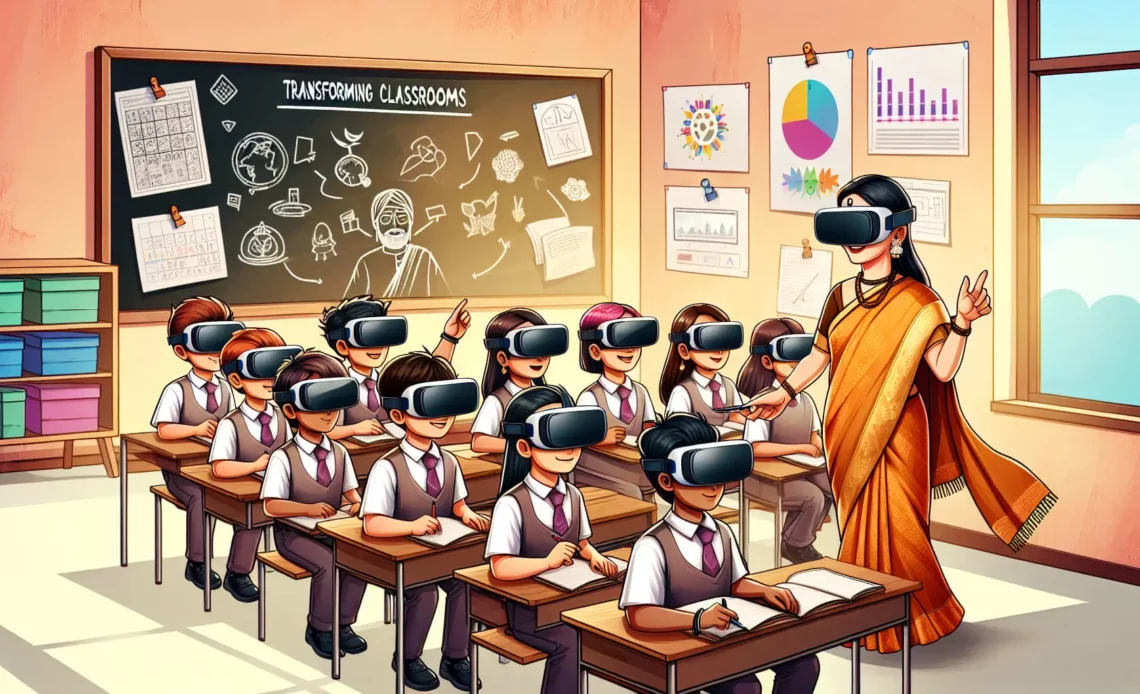This comprehensive study will explain Adoption of Virtual Reality in Indian Schools. In the rapidly evolving landscape of Indian education, virtual reality (VR) is making significant inroads, transforming the traditional classroom into a dynamic learning environment.
With a significant majority of participants showing a preference for VR as a supplementary tool to traditional teaching methods, and subjects such as science and mathematics identified as benefiting the most from virtual reality in Indian school education, the promise for an immersive learning future is undeniable. Despite the optimism, challenges related to cost, accessibility, and content availability remain paramount, necessitating collaborative efforts and strategic policy-making to fully harness the potential of VR in education.
The Evolving Landscape of Indian Education
Overview of the Indian Education System
The Indian education system, one of the largest globally, encompasses over 1.5 million schools, 1,250 universities, 50,000 colleges, and 13,000 higher education institutions, serving more than 300 million students across various educational segments. This vast network faces significant challenges, including outdated transmissionist teaching methods and a lack of authentic learning experiences, which hinder the development of creative thinking and logical reasoning.
Anticipated Transformations in Indian Education
Economic and Policy Driven Changes
The sector is poised for a transformative shift, influenced by rising per capita GDP and Gross Enrollment Ratios, with projections suggesting the education market could reach US$ 200 billion by 2024, growing at a Compound Annual Growth Rate (CAGR) of 15% over the next 2-5 years. The implementation of the New Education Policy (NEP) 2020 is set to introduce substantial reforms, focusing on vernacular languages, a holistic, multidisciplinary, and inclusive education system, and an experiential learning curriculum.
Technological Integration and Curriculum Reforms
Schools are increasingly integrating online learning with traditional classroom methods to offer more personalized and flexible educational experiences. Future curricula will likely emphasize environmental consciousness, entrepreneurship, and project-based learning to better prepare students for modern challenges. Additionally, skill development programs and enhanced career guidance are expected to equip students more effectively for the evolving job market.
Focus on Mental Health and Well-being
Recognizing the importance of mental well-being, educational institutions are beginning to incorporate mental health education and services into their offerings, aiming to provide a more supportive environment for students.
Expansion in Higher Education
The NEP 2020 also aims to revolutionize higher education by promoting multidisciplinary studies and integrating vocational education, with provisions for multiple entry and exit points. This policy encourages higher education institutions to expand their online and distance learning programs, thereby making higher education more accessible.
Industry and Global Collaborations
To align educational outcomes with job market needs, there is a growing emphasis on collaborations between universities and industries. Plans are also underway to transform higher education institutions into research centers that foster innovation and support start-ups. With the goal of positioning India as a global study destination, there is an expected increase in foreign collaborations, student exchanges, and the establishment of international campuses by reputed foreign universities in India.
Emphasis on Digital and Sustainable Practices
In response to the increasing relevance of technology and environmental sustainability in the job market, there is a greater focus on equipping students with digital skills and knowledge about sustainable practices. Additionally, there is an increase in government and private initiatives aimed at expanding vocational training and skill development programs, particularly in rural and underserved areas, to improve employability and bridge the skills gap.
Benefits of Virtual Reality in Indian Schools
Immersive Learning and Enhanced Creativity
Virtual reality (VR) and augmented reality (AR) are transforming educational landscapes by providing immersive learning experiences that inspire creativity and engagement among students. AR adds a layer of educational content to the real world, while VR immerses users in a completely digital environment, making learning interactive and impactful.
Understanding Complex Concepts
Both VR and AR have proven effective in helping students grasp complex academic concepts. By offering new perspectives and interactive opportunities, these technologies cater to various learning styles and preferences, enhancing the educational process.
Cultural Exposure and Empathy Development
VR promotes cultural competence and empathy by exposing students to diverse cultures and perspectives. This not only enriches their social understanding but also broadens their global awareness. Additionally, VR scenarios allow students to experience various social situations, fostering empathy and understanding.
Improved Academic Performance
Studies indicate that VR can significantly enhance student outcomes, including higher test scores and improved retention of information. VR has been shown to improve knowledge retention by up to 75%, and increase test scores by as much as 20%.
Collaborative Learning and Social Skills
VR also enhances teamwork and social skills through collaborative learning environments. This not only helps in building interpersonal skills but also prepares students for modern workforce challenges.
Special Education and Accessibility
VR opens new doors for special education, offering unique opportunities that may not be possible in traditional settings. It provides accessible learning experiences for students with disabilities, including autism, by tailoring educational content to meet their specific needs.
Real-World Applications and Safe Practice
VR simulations offer a safe space for students to practice real-world scenarios without risks, bridging the gap between theoretical knowledge and practical application. This is particularly beneficial in fields requiring hands-on experience, such as medicine and engineering.
Multilingual and Inclusive Education
VR technology supports multilingual learning, allowing students from different linguistic backgrounds to access the same educational content, thus promoting inclusivity.
Bridging Educational Gaps
VR not only enhances engagement and interactive learning but also has the potential to bridge the urban-rural educational divide, providing quality educational experiences across diverse geographic locations.
Global Perspectives and Personalized Learning
VR facilitates global collaboration and offers personalized learning experiences through AI-driven algorithms. This encourages cross-cultural interactions and provides immediate feedback, which supports a growth mindset among students.
Cost-Effective Learning Solutions
By reducing the need for physical materials, transportation, and infrastructure, VR contributes to cost-effective educational solutions, making learning more accessible and sustainable.
Challenges and Solutions for Implementing Virtual Reality in Indian Schools
High Costs and Access Limitations
- High Cost of VR Equipment and Content: The substantial expense associated with VR technologies poses a significant barrier. Solutions include exploring economies of scale and technological advancements that may reduce costs over time.
- Access in Rural Areas: The lack of VR technology access in rural schools is a major concern. Solutions involve increasing investments in infrastructure to extend the reach of VR technologies to these underserved areas.
Educational and Technical Challenges
- Resistance from Educators: Some teachers show reluctance towards integrating VR due to unfamiliarity with the technology. Gradual incorporation into training programs can help ease this transition.
- Need for Quality VR Content: There is a critical need for high-quality educational content in VR. Starting with off-the-shelf simulations and gradually building internal capacity can address this issue.
- Continuous Professional Development: Ensuring that educators receive ongoing training and technical support is crucial for the effective use of VR in classrooms.
Socioeconomic and Technical Hurdles
- Socioeconomic Disparities: These disparities can hinder the equitable implementation of VR. Collaborative efforts and strategic policies are recommended to mitigate these challenges.
- Technical Hurdles: Overcoming technical challenges requires consistent technological advancements and adequate training for educators.
Health and Safety Concerns
- Health Concerns: Managing health and safety implications, such as cyber-sickness, is crucial. More investment in adapting students to VR and setting safety guidelines is necessary.
- Inclusivity in VR Usage: Ensuring that VR solutions accommodate various disabilities is essential for inclusive education. This includes providing non-headset options and adapting content for different needs.
Enhancing Engagement and Support
- Parental and User Attitudes: Addressing concerns from parents and users about VR involves ensuring moderation and providing clear benefits of VR in education. Schools must engage parents actively to increase support for VR learning.
- Teacher Training and Resources: Adequate training and resources for teachers are vital to overcome resistance and effectively implement VR in education.
Case Studies: Success of Virtual Reality in Indian Schools
VR Implementation in Delhi Schools
A recent initiative in a Delhi-based school saw the introduction of VR labs, which not only sparked enthusiasm among students but also led to noticeable improvements in their academic performance. This integration of virtual reality into the existing curriculum was designed to complement traditional teaching methods, enhancing rather than replacing them. The positive outcomes of this approach were measured through formative assessments conducted in the classroom, underlining the effectiveness of VR in educational settings.
Detailed Study on VR’s Impact
A comprehensive case study conducted from January 2021 to October 2021 examined the implementation of VR in Indian schools. The study involved 122 primary school pupils, evenly split between males and females, with an average age of 10.11 years. Results from ANOVA analysis demonstrated that the use of textual cues in VR significantly improved both learning performance and the development of mental models in students. Additionally, the implementation of summarizing scaffolding techniques was found to remarkably enhance these mental models, suggesting that structured VR content can deeply influence cognitive outcomes.
Pedagogical Integration of VR
The case study further emphasized the potential benefits of integrating VR with traditional pedagogical approaches. By aligning VR technology with educational strategies, schools can significantly enhance educational outcomes, making learning more engaging and effective. This integration not only supports academic performance but also prepares students for a technologically advanced world, equipping them with the skills necessary to navigate and succeed in a digital landscape.
Conclusion
As the Indian education system embraces the transformative potential of virtual reality (VR), it stands on the cusp of revolutionizing traditional pedagogical methodologies and fostering more engaging, immersive, and effective learning environments. The evidence, drawn from enthusiastic educator and policymaker support to the tangible improvements in student engagement and performance, underscores the significant impact of VR in education. Yet, the adoption of this technology is not without its challenges—ranging from cost and accessibility issues to the need for quality content and continuous professional development for teachers. These hurdles necessitate a collaborative approach, incorporating strategic policy-making and innovative solutions to ensure VR’s benefits can be fully realized across the diverse landscape of Indian education.
Looking forward, the integration of VR into Indian schools proposes not just an enhancement of learning outcomes but a redefinition of educational experiences. By fostering skills like empathy, cultural competence, and technological proficiency, VR equips students to thrive in a rapidly changing world. The journey towards the widespread implementation of VR in education is undeniably complex and requires the collective efforts of educators, industry experts, and policymakers. However, as demonstrated by successful case studies and the potential for VR to bridge educational gaps, the journey is worth embarking on, promising a future where Indian students are not just consumers of knowledge but active, engaged participants in their learning journey.
FAQs
What advantages does virtual reality offer in educational settings?
Virtual reality in the classroom can significantly enhance empathy among students. Educators can use VR to immerse students in different perspectives, allowing them to experience diverse cultures or understand the lives of refugees, thereby fostering emotional awareness and empathy.
In what ways is virtual reality expected to transform the educational landscape?
Virtual reality can be particularly beneficial for students who struggle with attention deficit disorders or are prone to distractions. VR has the potential to maintain their focus and increase engagement, which can result in more profound learning experiences. Additionally, it allows teachers to tailor instruction to individual student needs.
What are some potential downsides of using VR in educational contexts?
There are several disadvantages to consider when integrating virtual reality into education:
- High Cost: The technology can be expensive to implement.
- Technical Difficulties: Users may encounter technical issues.
- Potential for Distractions: VR might lead to off-task behavior.
- Lack of Social Interaction: There could be a reduction in face-to-face interactions.
- Health Concerns: VR usage can be associated with negative health effects.
- Limited Content: There may be a scarcity of educational VR content.
- Potential for Addiction: There’s a risk of becoming addicted to VR environments.
- Security Concerns: Privacy and data security can be issues with VR technology.



